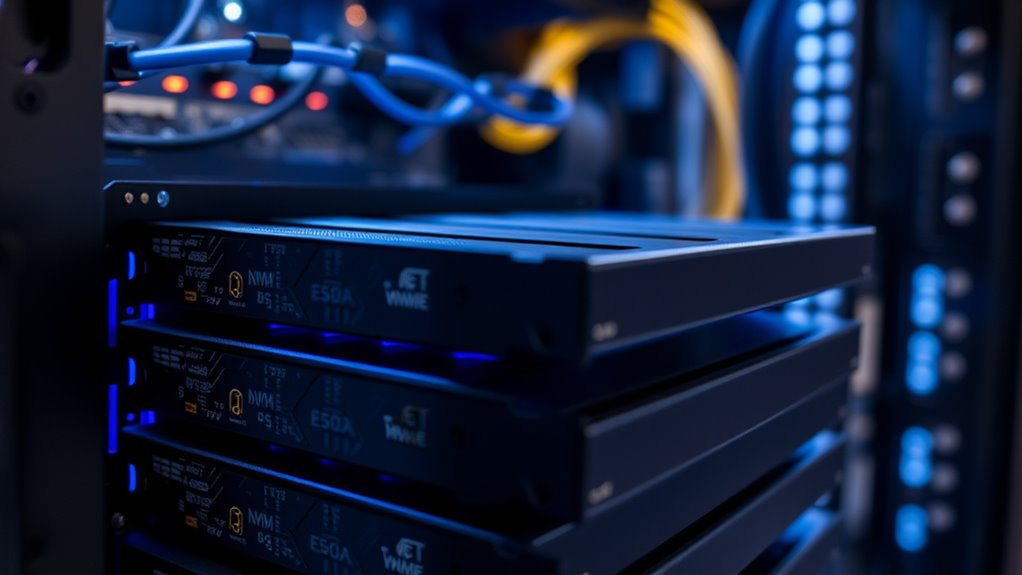To maximize I/O performance with NVMe SSDs and RAID, select the right RAID level like RAID 0 or 10 to balance speed and redundancy. Use proper strip sizes, align partitions, and tune cache settings for your workload. Choose hardware RAID for stability or software RAID for higher peak bandwidth. Make certain your system is cooled and free of bottlenecks, and consider encryption impacts. Keep exploring to discover optimization strategies that open your setup’s full potential.
Key Takeaways
- Use hardware RAID controllers like Intel VROC to achieve lower latency and stable, scalable high throughput for NVMe SSDs.
- Select optimal RAID levels (e.g., RAID 0 or 10) and appropriate strip sizes (64KB–256KB) aligned with workload patterns.
- Properly tune system parameters such as queue depth, cache policies, and ensure correct partition alignment to reduce overhead.
- Minimize encryption overhead by employing hardware encryption or disabling unnecessary software encryption processes.
- Ensure adequate cooling and monitor SSD SMART attributes to prevent thermal throttling and maintain peak performance.
Understanding NVMe SSD Performance Metrics in RAID Setups

Understanding NVMe SSD performance metrics in RAID setups is essential for optimizing storage systems. You should focus on IOPS and throughput, which reveal how well your configuration handles workload demands. For example, RAID5 random write IOPS might reach around 200,000, but this is often lower than vendor claims due to configuration bottlenecks. Intel VROC RAID5 arrays can scale read bandwidth linearly, with a 12-drive setup approaching 29 GB/s. Consumer NVMe drives like the Samsung 970 Plus peak at about 3.3 GB/s, but speeds drop to 1.6 GB/s once caches fill. RAID 0 needs multiple drives—usually 8 or more—to sustain 100 Gbps write speeds. Keep in mind that PCIe and RAID controller bottlenecks, along with internal drive architectures, considerably influence these performance metrics. Additionally, understanding performance metrics in different RAID configurations can help identify bottlenecks and optimize overall system performance, especially considering the internal architecture of NVMe drives that impacts data transfer rates.
Leveraging Hardware and Software RAID for Optimal Throughput

When choosing between hardware and software RAID, consider your performance needs and budget. Hardware RAID offers lower latency and dedicated resources, making it ideal for consistent throughput, while software RAID can provide higher bandwidth with more flexibility. To maximize speed, you need to understand how each option’s strengths and limitations align with your specific storage setup. Additionally, selecting a dedicated controller that reflects your performance requirements can help ensure optimal operation.
Hardware vs. Software RAID
Choosing between hardware and software RAID depends on your workload requirements and system setup. Hardware RAID offers lower latency, stable throughput, and offloads processing from your CPU, making it ideal for databases and enterprise applications. It’s more reliable, with features like battery-backed cache and hot-swap drives, but requires dedicated controller hardware. Software RAID uses your host CPU and memory, often delivering higher peak bandwidth, especially with multiple disks. It’s flexible, easier to upgrade, and cost-effective, but can increase CPU load and impact performance during rebuilds. Consider this comparison:
| Feature | Hardware RAID | Software RAID |
|---|---|---|
| Performance | Low latency, stable throughput | Higher peak bandwidth |
| CPU Usage | Minimal | Higher during rebuilds |
| Scalability | Limited by controller capacity | Flexible, depends on host resources |
| Cost | Higher (hardware needed) | Lower (no extra hardware) |
| Reliability & Features | Enterprise-grade, cache backed | OS-dependent, flexible |
Additionally, hardware RAID can provide better fault tolerance and recovery options, which are critical for maintaining data integrity in enterprise environments.
Configuring for Maximum Speed
Maximizing throughput in RAID configurations requires careful attention to strip size, layout, and hardware capabilities. Choose a strip size between 64KB and 256KB; 128KB often balances performance for mixed workloads. Match the strip size to your I/O patterns to boost effective throughput, especially in RAID 0 or RAID 10. Proper strip alignment with SSD page sizes reduces write amplification and latency. Leverage PCIe lanes effectively: each NVMe drive needs at least four lanes, and oversubscription causes bottlenecks. Use PCIe 4.0 or 5.0 for maximum bandwidth, ensuring your motherboard and CPU support these standards. Opt for direct CPU-attached NVMe drives to reduce latency. Fine-tune RAID block size, queue depth, and cache policies, and consider software RAID with multi-threading to outperform hardware limitations, pushing your storage system to its full potential. Additionally, understanding hardware capabilities can help you optimize your setup for peak performance.
Impact of Encryption and Data Transfer on NVMe RAID Efficiency

Encryption can considerably affect NVMe RAID performance, especially when using software-based methods that increase CPU load and reduce throughput. Transfer speeds are often limited by encryption overhead, causing slower read/write rates and potential bottlenecks. Understanding these impacts helps you choose the right encryption approach to balance security and efficiency.
Encryption Overhead Effects
Encryption overhead can substantially affect NVMe RAID performance, especially when software-based solutions like LUKS or VeraCrypt are used. These methods put a heavy strain on your CPU, leading to higher utilization—sometimes up to 77.1%—and markedly slowing down read and write speeds. On NVMe SSDs, encryption can cause up to a 79% performance penalty during sequential writes. Unlike hardware encryption, which minimally impacts performance, software encryption adds complexity and extra processing, especially in RAID setups. RAID-1, in particular, is affected because of the overhead for redundancy combined with encryption. As a result, your system’s throughput drops, and CPU resources become a bottleneck. Managing encryption methods and understanding their impact is vital to maintaining peak NVMe RAID efficiency. Additionally, choosing appropriate encryption techniques can help mitigate some of these performance issues.
Transfer Speed Limitations
While encryption overhead can slow down NVMe RAID performance, other factors also limit transfer speeds, especially when working with high-bandwidth interfaces like Thunderbolt and PCIe. Thunderbolt 3 and 4 cap data transfer at around 2.85 GB/s per channel, regardless of SSD or RAID setup, and most Macs have only two channels, restricting RAID scalability. Connecting multiple drives through a single port doesn’t increase speeds due to bandwidth limits. PCIe bandwidth varies: PCIe 3.0 x4 offers about 4 GB/s, PCIe 4.0 doubles that, and PCIe 5.0 reaches roughly 16 GB/s. However, motherboard lane allocation, controller overhead, and platform support often prevent reaching these peaks in real-world scenarios, capping overall transfer speeds. Additionally, leadership in technological innovation plays a crucial role in overcoming these hardware limitations through advancements in interface design and system architecture. Embracing mindfulness of hardware constraints can help in optimizing system configurations for better performance.
Comparing Management Methods and Hardware Requirements for NVMe RAID

When comparing management methods and hardware requirements for NVMe RAID, it’s crucial to understand how different configurations impact performance, flexibility, and cost. Hardware RAID offers higher performance and lower latency, making it ideal for demanding applications, but it comes with a higher price tag. Software-defined RAID provides greater flexibility and cost savings, allowing you to configure and manage drives through OS tools or specialized software like Xinnor.io. This approach is often more adaptable for changing workloads and scalable environments. Keep in mind that NVMe technology connects directly to the CPU via PCIe, which can challenge hardware controllers’ capabilities, sometimes limiting performance. Proper tuning and configuration are essential to maximize throughput, regardless of the management method you choose. Additionally, it’s important to consider the impact of cookies used in monitoring and optimizing system performance, as well as understanding meditation practices that can help reduce stress and improve focus during system setup and maintenance. To further enhance your system’s efficiency, paying attention to system cooling is vital to prevent thermal throttling and maintain optimal NVMe SSD performance. Exploring hardware compatibility is also key to ensuring your setup runs smoothly without bottlenecks or hardware conflicts.
Analyzing CPU Utilization and Bottlenecks in High-Performance NVMe Arrays

Understanding CPU utilization in high-performance NVMe arrays is essential for avoiding bottlenecks and maximizing throughput. NVMe SSDs reduce host CPU load per I/O through streamlined command processing and direct PCIe access. However, CPU cycles are still spent on the OS stack, device drivers, and managing RAID overhead, especially with complex parity configurations like RAID 5 or 6. As workload complexity increases, so does CPU demand, making high-core-count CPUs necessary to sustain extreme IOPS. Increasing queue depth improves internal parallelism and throughput but raises CPU load at higher levels, with diminishing returns once saturation occurs. Monitoring CPU usage alongside storage metrics helps identify whether CPU capacity, rather than bandwidth, limits performance, ensuring you optimize hardware to avoid bottlenecks and achieve maximum efficiency. Additionally, implementing AI-driven monitoring tools can enhance real-time analysis of system performance and proactively address potential constraints.
Troubleshooting Common Challenges in NVMe RAID Deployment

Deploying NVMe RAID arrays often involves steering hardware and configuration challenges that can impact performance and reliability. One major issue is PCIe lane allocation; traditional RAID controllers with limited lanes cause bottlenecks, especially when connecting multiple SSDs. Oversubscription reduces per-drive speeds, but advanced PCIe switches like ATTO ExpressNVM help optimize lane distribution. Heat buildup is another concern, as high-density setups generate significant thermal stress, necessitating effective cooling to prevent throttling and drive failures. Power delivery issues, including voltage drops during peak loads, also threaten stability. Compatibility problems may arise from BIOS, driver, or firmware mismatches, leading to unpredictable behavior. Regular updates and thorough testing are essential to avoid data corruption. Additionally, monitoring health via NVMe SMART attributes helps identify failures early and maintain array integrity. Proper thermal management is critical to prevent overheating in dense NVMe RAID configurations. Properly configuring RAID levels and understanding workload distribution can also enhance overall system performance. Additionally, understanding divorce statistics and regional legal resources can be valuable for those facing legal disputes related to hardware or data recovery cases. Understanding performance tuning techniques allows for further optimization tailored to specific workloads.
Tips for Fine-Tuning Your NVMe RAID Configuration for Maximum I/O Gains

Maximizing I/O gains in your NVMe RAID setup requires careful fine-tuning of both hardware and software components. First, select the right RAID level for your workload—RAID 0 boosts speed but offers no redundancy, while RAID 1 ensures data safety. For balanced performance and protection, consider RAID 5 or 6, but be aware of potential write slowdowns. Use advanced hardware like Intel VROC or software solutions such as Xinnor xiRAID to bypass controller bottlenecks, leveraging PCIe lanes directly. Align partitions and filesystems to NVMe block sizes (4KB–16KB) to minimize overhead. Disable unnecessary journaling or checksumming, and employ direct I/O for latency-sensitive tasks. Regularly test configurations with tools like FIO to compare performance and guarantee your setup maximizes throughput and efficiency. Additionally, staying informed about battery technologies can help optimize your storage system’s energy efficiency and reliability, ensuring consistent performance.
Frequently Asked Questions
How Does NVME RAID Performance Vary Across Different Motherboard Chipsets?
Your NVMe RAID performance depends mainly on your motherboard chipset. Higher-end chipsets like AMD X570, TRX40, and Intel Z790 support multiple PCIe 4.0 lanes, enabling faster RAID arrays. Lower-tier chipsets may limit the number of NVMe drives or reduce bandwidth, affecting speeds. Using native RAID support and proper lane allocation, you’ll get better performance, but the actual gains depend on your specific motherboard’s PCIe lane configuration and driver support.
What Are the Best Practices for Balancing CPU Load in Large NVME RAID Arrays?
You should aim to keep CPU utilization below 70% during peak loads for ideal performance. Use hardware RAID controllers with dedicated processing to offload tasks, and balance I/O interrupts across CPU cores through IRQ affinity and CPU pinning. Adjust RAID stripe sizes based on workload, disable unnecessary features like native multipath, and tune kernel settings such as rq_affinity and io_poll_delay. These steps help distribute CPU load evenly, maximizing throughput and reducing bottlenecks.
How Does Firmware Version Impact NVME RAID Stability and Speed?
Your firmware version directly impacts NVMe RAID stability and speed. Up-to-date firmware resolves bugs, enhances error handling, and supports full NVMe protocols, leading to fewer disconnects and array degradation. It also optimizes data paths, increases throughput, and manages PCIe bandwidth efficiently. By keeping firmware current, you guarantee better compatibility, more reliable performance, and faster data transfer rates, maximizing your RAID array’s overall stability and speed.
Can NVME RAID Configurations Be Optimized for Mixed Workloads?
Did you know that RAID 5 and RAID 10 offer the best balance for mixed workloads? You can optimize NVMe RAID configurations by selecting these RAID levels to balance speed and redundancy. Confirm your drives are matched in capacity and performance, and monitor your system’s workload patterns. Using hardware or software RAID solutions that support parallel processing helps maintain high throughput while protecting data integrity during diverse I/O operations.
What Security Considerations Are Critical When Deploying Encrypted NVME RAID Systems?
When deploying encrypted NVMe RAID systems, you must guarantee strong key management, preferably with external servers or dedicated onboard modules, to prevent unauthorized access. Limit physical access and monitor for tampering. Use FIPS-certified drives and enable audit logging to track access events. Regularly rotate keys, securely destroy old ones, and verify drive configurations to prevent data leaks or vulnerabilities, maintaining robust data security throughout your deployment.
Conclusion
While optimizing NVMe SSDs with RAID can boost your I/O performance significantly, don’t overlook the importance of balancing your setup. Some might think hardware alone guarantees results, but proper tuning, management, and understanding your workload are key. By carefully configuring your RAID and considering factors like encryption and CPU load, you’ll unlock the full potential of your NVMe arrays—delivering faster, more reliable storage without sacrificing stability.









